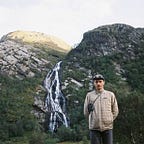Pt 1. Responsibility of mountain biking within our socio-environmental crises
Writing this off the back of a conversation Andy Bennett shot with Patagonia Bristol to accompany with a few more ‘in full’ thoughts that couldn’t be captured. We had a chat about steps us mountain bikers (extends to all outdoor activities/play/adventures) can all take to limit our footprints on planet earth, an invitation and not a prescription.
Also written a Pt.2 about the massive OPPORTUNITY to shift our community’s culture and start using mountain biking as a force for good: https://stantownsend.medium.com/pt-2-opportunity-for-mountain-biking-within-our-socio-environmental-crises-5fb8e46bcb6c
A big thanks to Bonnie, Ollie, Andy and Patagonia Bristol for making it happen.
Individual steps
There is rightly a lot of discussion on the balance of responsibility across society in addressing the interlinked crises we collectively face (1). Institutions of power and those in them, have a clear a duty to pull the levers of change those outside cannot. They should rightly be held accountable for developing a fairer, more accessible, and sustainable system for us all to operate in.
However, power to make change doesn’t sit entirely with the those in power. We as individuals have agency and immense potential to create a more sustainable society (2). This begins with acknowledging the challenges, your own agency and then starting a journey of change.
But what changes? Where to start? Andy and I have you covered. Our discussion is all about the changes that us mountain bikers can make (non-mountain bikers also welcome), starting today! Recap at the bottom.
In keeping true, a single more sustainable choice shouldn’t be considered as ‘problem solved’, but rather, part of a journey of learning to participate more appropriately with the natural world. Sustainability is often thought of as a fixed, permanent state, when in reality it is an ever-changing aspiration.
A further word specifically on us mountain bikers, for whom this journey is especially valid. One, given all the benefits we get from riding it natural spaces, it makes pretty good sense to look after them. Two, we consume a lot, like the raw materials and greenhouse gases used to produce our bikes. Reducing the impact of our global extraction and emissions is the right thing to do, for all of those without the luxury of being able to ride.
Hope you find this and the conversation between Andy and I useful. More to come in Pt.2 on what we as mountain bike community can do.
Enjoy the ride,
Stan
1. Just referencing climate change (despite is size), doesn’t do what we’re facing justice. It’s not just climate change its also rapid biodiversity loss and pollution prevention (aka converging crises). All of which have intersections with other challenges facing society, such as inequality, race and gender.
2. This note and video is focussed on sustainability, which can help the beginning of your journeying contribution, but need not be the end.
Notes from the video
Step 1, Refuse
The most powerful thing you can do to reduce waste, pollution and your contribution to climate change as a consumer, is to refuse to purchase what you don’t need. By avoiding purchasing in the first place we can avoid all the energy, waste and pollution involved along the way.
Obviously deciding what you need is down to you as an individual, but collectively we should all be asking ourselves the question. Do I really need this? And:
· Is this part really going to make me faster?
· Do I need another t-shirt/piece of riding gear?
· Do I already have a piece of kit that’s going to fulfil this role?
· Can I make food to take riding? / Can I make a coffee beforehand and decrease use of single use plastics
Step 2, Reuse
Alongside thinking about avoiding purchasing something in the first place, we should be using and reusing what we already have efficiently.
So that means:
· Using what you have for as many purposes as you can — versatility
· Taking care of what you have
· Buying durable and repairable goods
· Using reusables, like keep cups and reused/2nd hand products
· Selling/donating on 2nd hand markets
This will extend the lifetime of what you’ve got as far as possible and making use of what’s already out there, so the resources tied up in what we use are well spent!
Step 3, Reduce
If you have to buy something and refuse is off the cards and you can’t reuse something or purchase something used, then have a think above how you can reduce the impact of what you doing or buying.
With products, thanks to the money you’ve saved through refusing and reusing things, go for products that perform the best environmentally, are made of the best materials and will last the longest. Look out for:
· B-Corps/1% for the Planet companies
· Standards like: Blue-Sign approved certification for more sustainable textile production; Global Organic Textile Standard and Fairtrade for organic cotton fibres
· Also, try to ride local more where possible and lift share when not.
Step 4, Dispose
Last of all, when it does come to end-of-life of your t-shirt, bike part, coffee cup whatever — dispose of it in the correct way.
This means:
· Taking rubbish home to sort correctly.
· Recycling bike parts through bike shops, council recycling centres etc.
· Donating/selling unneeded gear (may have gone over in re-use already)
